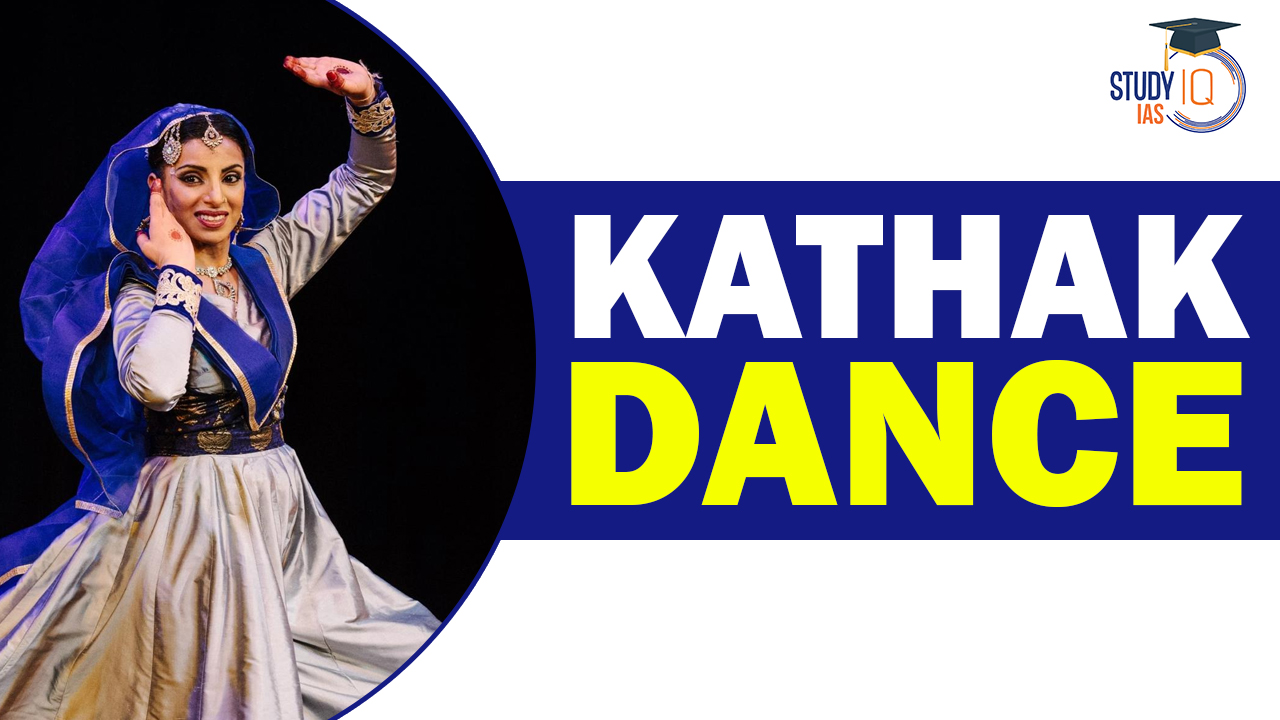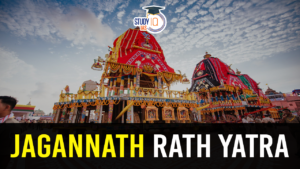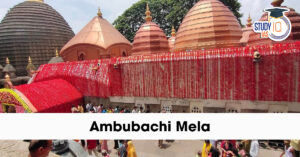Table of Contents
Kathak, a revered Indian classical dance, is believed to trace its origins to North Indian wandering bards known as Kathakars. Emerging during the Bhakti movement, this art form evolved as a means of storytelling through rhythmic foot movements, hand gestures, and facial expressions. Kathak incorporates tales from ancient mythology, especially those of Lord Krishna, captivating the courts of North Indian kingdoms. Notably, three prominent schools or gharanas—Jaipur, Benaras, and Lucknow—emphasize distinct aspects, varying between footwork and dramatic expression.
We’re now on WhatsApp. Click to Join
Kathak: Indian Classical Dance
Kathak is one of the eight classical dance forms of India, known for its expressive storytelling through intricate footwork, hand gestures, and facial expressions. Originating from the northern regions, particularly in Uttar Pradesh, Kathak has evolved from traditional temple performances to the sophisticated art form seen today.
It includes elements like rhythmic footwork (tatkar), spins (chakkar), and storytelling (abhinaya). The dance form often adapts to both classical and contemporary themes, making it a dynamic and versatile expression of Indian culture. Kathak is accompanied by classical North Indian music, including tabla, sitar, and sarod.
Kathak Dance History and Evolution
- Ancient Origins: Kathak traces its roots to the Sanskrit Hindu text “Natya Shastra,” attributed to Bharata Muni between 200 BCE and 200 CE.
- Art of Storytelling: The dance form evolved from the storytelling tradition of North Indian Kathakars, akin to early Greek theatre, conveying legends through music, dance, and songs.
- Bhakti Movement Influence: Kathak flourished during the Bhakti movement, focusing on theistic devotion in medieval Hinduism. Performers expressed stories through rhythmic footwork, hand gestures, facial expressions, and eye movements.
- Gharanas (Schools): Prominent gharanas include Jaipur, Benaras, and Lucknow, each emphasizing specific aspects like footwork or acting.
- Lucknow Gharana and Bhakti Connection: The Lucknow Gharana, founded by Ishwari Prasad, aligns with the Bhakti movement, incorporating dance as a form of worship, particularly devoted to Lord Krishna.
- Mughal Era Integration: Kathak gained popularity in Mughal courts, adapting to a more sensual form with influences from Central Asian and Persian themes.
- Colonial Era Challenges: During colonial rule, Kathak faced criticism, adapting to entertain Mughal courts with erotic elements. Missionaries and officials disparaged the dance form, leading to a decline.
- Revival Efforts: Despite colonial opposition, Kathak survived through efforts by families, and its revival gained momentum during the Indian freedom movement. Kalkaprasad Maharaj played a crucial role in the early 20th-century revival.
- Current Status: Kathak stands as a dynamic classical dance, blending ancient Indian tradition with influences from various cultures. Its revival preserved and showcased the rich cultural heritage of India.
Kathak Dance Repertoire
Invocation:
- The dancer pays homage to her guru, onstage musicians, and Hindu deities through mudras and facial expressions.
- In Muslim traditions, a salami (salutation) is offered.
Nritta (Pure Dance):
- Begins with a graceful ‘thath’ sequence, featuring slow movements of eyebrows, neck, and wrists.
- Progresses to faster sequences of ‘bol,’ incorporating tora, tukra, parhant, paran, showcasing dynamic footwork, turns, and gestures.
- Synchronizes footwork (‘tatkars’) with musical beats, creating rhythmic sounds with ghunghru, often punctuated by sharp head turns.
Nritya (Expressive Dance):
- Involves storytelling, expressing spiritual themes, messages, or emotions.
- Utilizes expressive gestures and slower body movements, harmonizing with musical notes and vocals.
Kathak Dance Costumes
Hindu Female Dancers
- Traditional Sari Ensemble:
- Unique sari draping, accompanied by a choli (blouse) and a scarf or urhni in some regions.
- Alternatively, a long embroidered skirt paired with a contrasting choli and a transparent urhni.
- Adorned with gold traditional jewelry for the hair, nose, ears, neck, and hands.
- Musical anklets (ghunghru) with small metallic bells for rhythmic footwork.
- Vivid face makeup accentuates expressions.
Hindu Male Dancers
- Silk Dhoti Ensemble:
- Silk dhoti paired with a silk scarf tied on the upper body or covered by a loose jacket.
- Simple stone jewellery, less elaborate than female counterparts.
Muslim Female Dancers
- Chic and Modest Attire:
- Skirt with a tight-fitting churidar or pyjama, paired with a long coat covering the upper body and hands.
- Headscarf completes the ensemble, accompanied by light jewellery.
Kathak Instruments & Music
- Tabla:
- Harmonizes with rhythmic foot movements, creating a jugalbandi with the dancer.
- Mimics footwork sounds or complements them.
- Manjira (Hand Cymbals):
- Used for rhythmic accompaniment.
- Sarangi or Harmonium:
- Provides melodic support to the performance.
Famous Kathak Exponents
- Gharana Founders:
- Jaipur Gharana: Bhanuji
- Benaras Gharana: Janaki Prasad
- Lucknow Gharana: Ishwari Prasad
- Raigarh Gharana: Raja Chakradhar Singh
- Lucknow Gharana Stalwarts:
- Shambhu Maharaj: Renowned guru.
- Lachhu Maharaj and Acchan Maharaj: Brothers and stalwarts in Kathak.
- Modern Day Kathak Icon:
- Pandit Birju Maharaj: Leading advocate of the Lucknow Kalka-Bindadin gharana.
- Legendary Kathak Queen:
- Sitara Devi: Described as Nritya Samragini (Empress of Dance) by Rabindranath Tagore.
- Other Eminent Artists:
- Roshan Kumari, Shovana Narayan, Maya Rao, Kumudini Lakhia: Contributed significantly to the art of Kathak.
Kathak Dance UPSC
Kathak, a revered Indian classical dance, originates from North Indian Kathakars during the Bhakti movement, telling stories through rhythmic footwork, hand gestures, and facial expressions. Evolving through the Jaipur, Benaras, and Lucknow gharanas, it thrived in Mughal courts, adapting during colonial challenges. Revived in the 20th century, Kathak blends tradition with versatility, using tabla, sitar, and sarod.
In performance, it pays homage, and engages in pure dance (Nritta), and expressive dance (Nritya). Hindu costumes feature saris or embroidered skirts, complemented by traditional jewellery. Muslim attire includes skirts with churidars. Instruments like tabla, manjira, and sarangi accompany, luminaries like Pandit Birju Maharaj and Sitara Devi enriching Kathak’s legacy.
| Other Classical Dances of India | |
| Bharatanatyam Dance | Kathak Dance |
| Kuchipudi Dance | Manipuri Dance |
| Kathakali Dance | Mohiniyattam Dance |
| Sattriya Dance | Odissi Dance |


 Bonalu Festival 2025: Date, History, Rit...
Bonalu Festival 2025: Date, History, Rit...
 Puri Jagannath Rath Yatra 2025, History,...
Puri Jagannath Rath Yatra 2025, History,...
 Ambubachi Mela 2025: Dates, Rituals, Sig...
Ambubachi Mela 2025: Dates, Rituals, Sig...





















